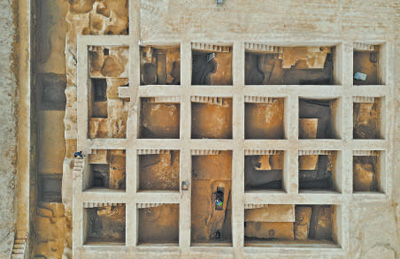 |
|
The archaeological excavation site of Nanyang Site in Xiong'an New Area.
Photographed by Mou Yu, a reporter from Xinhua News Agency
|
 |
|
The city wall is an important evidence to determine the nature of Nanyang site. The dense ramming nest is the mark left by the ramming of the city wall. The picture shows the archaeologists cleaning the rammed nest.
Photographed by Lei Jianhong (People's Vision)
|
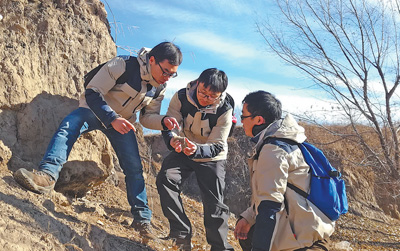 |
|
In December 2017, the joint archaeological team was conducting an archaeological survey.
Photographed by He Suili (People's Vision)
|
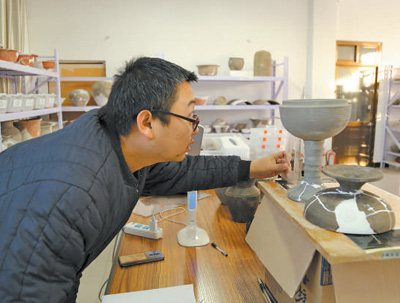 |
|
At present, hand drawing is still an important means of recording cultural relics information. Through section drawing, we can not only record more comprehensive cultural relics information, but also avoid the shortcomings of photos and computer three-dimensional mapping. The picture shows the pottery beans unearthed from Nanyang Site painted by archaeologists.
Photographed by Lei Jianhong (People's Vision)
|
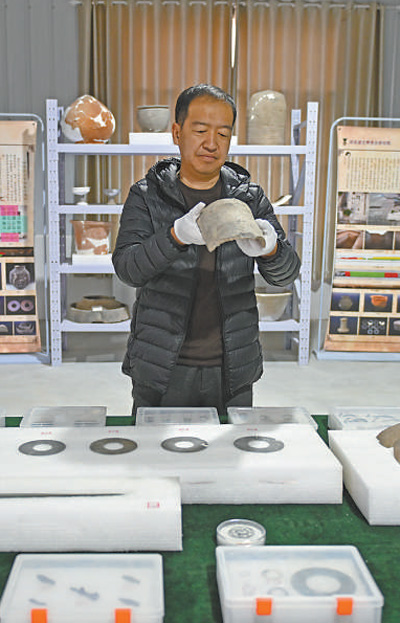 |
|
Lei Jianhong, the head of Xiong'an New Area Cultural Relics Protection and Archaeology Workstation, is sorting out the cultural relics unearthed at Nanyang Site.
Photographed by Mou Yu, a reporter from Xinhua News Agency
|
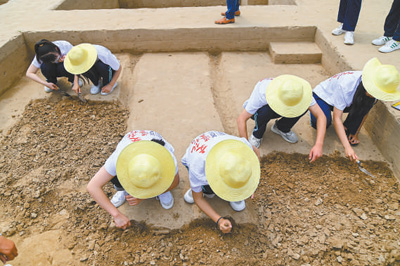 |
|
Students experience archaeology and cultural relic restoration at the Cultural Relics Protection and Archaeology Workstation in Xiong'an New Area.
Photographed by Lei Jianhong (People's Vision)
|
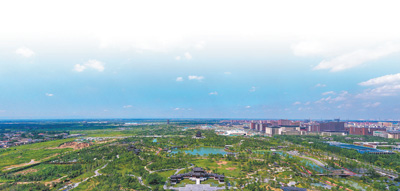 |
|
The ground is green and livable, and the underground has a thousand years of culture. The picture shows the scenery of Yuerong Park in Xiong'an New Area.
Photographed by Li Da (People's Vision)
|
 |
|
Taotie half tile unearthed from Nanyang Site in Xiong'an New Area.
Photographed by Lei Jianhong (People's Vision)
|
 |
|
The bronze pot unearthed from Nanyang Site in Xiong'an New Area is inscribed with the word "Xigong" in the head of the copper pot shop.
Photographed by Zhang Xiaozheng (People's Vision)
|
 |
|
"Yishi" pottery tablets unearthed from Nanyang Site in Xiong'an New Area.
Photographed by Zhang Xiaozheng (People's Vision)
|
 |
|
Sketch map of 8 city sites found in Xiong'an New Area.
Courtesy of Hebei Provincial Institute of Cultural Relics and Archaeology
|
In May 2017, one month after the establishment of Xiong'an New Area in Hebei Province, the archaeological work of Xiong'an cultural relics kicked off. The construction of the new area is a "millennium plan", and inheritance is the basis for development. Xiong'an New Area is one of the areas with the most intensive ancient cultural relics in Hebei, with many cultural relics and a long time span. At the beginning of its establishment, "persisting in protecting and carrying forward the excellent traditional Chinese culture and continuing the historical context" was an important part of the planning and construction of the New Area.
After 7 years of archaeological excavation, more than 4000 unearthed cultural relics, 263 immovable cultural relics and 8 ancient city sites have gradually clarified the historical context of Xiong'an: in the Neolithic Age, this is a concentrated area of human activities; About 3000 years ago, Chinese and Rongdi cultures collided and merged here; About 2000 years ago, Yan State built its capital "Linyi" and "Yi" here; About 1000 years ago, Song and Liao dynasties confronted and communicated here.
The conservation and archaeological work of Xiong'an cultural relics not only laid the foundation for the planning and construction of the new town, but also injected vitality and soul into the new town. Now, walking on the street of Xiong'an New District, Yining Street, Yanzhao Street... these street names transformed from archaeological achievements are interpreting the city's heritage and charm in another way.
Coordinated promotion of construction archaeology
"We must race against time, complete the archaeological survey and excavation as soon as possible, and find precious objects for understanding and protecting the cultural relics in Xiong'an," said Lei Jianhong, head of the Cultural Relics Protection and Archaeology Workstation in Xiong'an New Area.
In May 2017, before the commencement of the construction of the new area, Lei Jianhong accompanied the team of Hebei Provincial Institute of Cultural Relics and Archaeology to Xiong'an, and formed a joint archaeological team with colleagues from the Archaeological Institute of the Chinese Academy of Social Sciences, the Archaeological Institute of the Palace Museum, the National Museum Archaeological Institute and other units to carry out cultural relics investigation and survey in the new area.
The archaeological work in Xiong'an New Area is different from that in the past. It is not carried out in the form of a single construction project or a local plot, but needs to promote the protection of cultural relics and project construction as a whole, said Chen Hui, deputy director of the Publicity Network Information Bureau of Xiong'an New Area.
Lei Jianhong introduced that the archaeological work is generally divided into three steps: the first step is archaeological investigation, which analyzes the scope and status of the distribution of cultural relics through information collection; The second step of archaeological exploration is to collect soil samples through Luoyang shovel and other tools to further verify the results of archaeological investigation; The third step is archaeological excavation. Only through excavation can we confirm the age, type and cultural connotation of the remains and fully understand the remains.
In order to scientifically standardize the archaeological work and improve the accuracy and efficiency of the archaeological work, the joint archaeological team has enriched and innovated the means of archaeological work, using methods including RTK (real-time dynamic carrier phase difference technology) layout, 3D modeling, aerial mapping and other methods to improve the depth and breadth of information extraction; At the same time, targeted research and development of Hebei archaeological comprehensive business management platform, real-time upload of archaeological records, centralized management, safe storage, centralized verification, fast retrieval, and research sharing have played an exemplary role in promoting digital archaeology.
The archaeological work carried out in an orderly manner has achieved a series of fruitful results: the joint archaeological team carried out a systematic archaeological survey of the 1770 square kilometers planned for Xiong'an New Area, completed the archaeological exploration and trial excavation of 83 ancient sites and ancient tombs in the starting area, with an exploration area of 4.12 million square meters, providing an important reference for the scientific planning and steady construction of the new area.
In 2020, with the release of the Regulatory Plan for the Starting Area of Hebei Xiong'an New Area, the construction of the new area will be accelerated in an all-round way, urban changes will change with each passing day, and the protection of cultural relics will become more urgent. "In the large-scale infrastructure construction, there is a risk that new cultural relics will be found and damaged at any time," Lei Jianhong said.
In this regard, Hebei Xiong'an New Area Management Committee has set up a special agency to coordinate the cultural relics protection and archaeological work in the new area, so as to solve the contradiction between the construction of the new area and the archaeological work, and promote the coordinated development of economic construction, cultural relics protection and archaeological research. For example, the originally planned line of Haiyue Street in the start-up area crosses the protection area and construction control zone of Nanyang Site. According to the opinions of the cultural relics department, Haiyue Street has adjusted its route design to completely avoid Nanyang Site; The Xiongmao Road (Phase II) under construction was originally planned to pass through the ancient city site and Maozhou city site. After expert argumentation, the design scheme was also adjusted to bypass the two sites.
The new city is also an ancient city
Nanyang Site, the first place to start archaeological excavation in Xiong'an New Area and the largest national key cultural relics protection unit in the New Area, is a microcosm of Xiong'an archaeological work.
Guo Yong, a member of the Nanyang Site Archaeological Team in Xiong'an New Area, said that the ancient site is generally named after the village to which it belongs. The site belongs to Nanyang Village, so it is named Nanyang Site.
Archaeological excavations in recent years have basically confirmed that the main culture of Nanyang Site in Xiong'an New Area is the Yan culture in the Eastern Zhou Dynasty, which is composed of two Warring States city sites.
How to confirm?
Guo Yong said that some important cultural relics, such as "Xigong" copper pot, "Zuozhi" copper pot cover, "Youzheng Yin" copper pot cover, and "Yishi" pottery pieces, have been unearthed at the site, all of which show the style of Yan artifacts.
The "Zheng" in "Zuo Zheng" and "You Zheng Yin" may be the name of the government office in Yan. The "Western Palace" bronze pot is directly related to the Imperial Palace of the Yan Dynasty. "Yishi" pottery pieces more directly indicate that Nanyang Site in Xiong'an New Area may be the place where "Linyi" or "Yi" is located in the capital of Yan. According to historical records, the State of Yan moved its capital five times. Marquis Yan Huan moved to "Lin Yi", and Duke Yan Wengong moved to "Yi". The archaeological team found a Warring States tomb 1600 meters northwest of Nanyang Site in Xiong'an New Area. Both the shape of the tomb and the unearthed artifacts are typical features of Yan culture. The tomb and the city site were found together, confirming each other, further proving the age and nature of the site.
Li Lei, a member of the Nanyang Site Archaeological Team in Xiong'an New Area, recalled that when the "Yishi" pottery tablets were unearthed, everyone didn't care. At that time, many cultural relics of Nanyang Site in Xiong'an New Area were excavated in ash pits (garbage pits piled up after the discarded living utensils of ancient people). "Yishi" pottery flakes are very small and stained with soil and mud. In addition, there were many pottery flakes before, and "Yishi" did not appear until the pottery flakes were cleaned.
Lei Jianhong introduced that through the archaeological survey of Nanyang Site and its surrounding areas, he found that the "Great Nanyang" site settlement group with Nanyang Site and Liangmatai Site as the core, whose cultural heritage lasted for nearly 3000 years from the late Neolithic Age to the Song and Jin Dynasties, is an important part of the millennium history and culture of Xiong'an New Area, It is also an important cultural resource for the development and construction of Xiong'an New Area.
Lei Jianhong introduced that there are still 7 similar ancient city sites confirmed by archaeological exploration or excavation in Xiong'an, which jointly explore the historical context of the new area and reveal the profound cultural heritage of Xiong'an. Some of the archaeological sites have been opened to the public, and activities have been held irregularly to give the public a chance to further understand the history and culture of Xiong'an.
People's Daily (May 18, 2024, Version 07)
(Editor in charge: Lin Fusheng, Fang Tong)
Share to let more people see













































